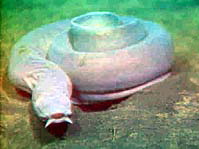
Back قحفيات Arabic Kəlləlilər Azerbaijani Баш һөйәклеләр Bashkir Чарапныя BE-X-OLD Craniata BS Craniats Catalan Craniata Czech Κρανιωτά Greek Kraniulo Esperanto Craniata Spanish
| Craniates | |
|---|---|

| |
| A Pacific hagfish, an example of (what was thought to be) a "non-vertebrate craniate" | |
| Scientific classification | |
| Domain: | Eukaryota |
| Kingdom: | Animalia |
| Phylum: | Chordata |
| Clade: | Olfactores |
| Clade: | Craniata Lankester, 1877[2] |
| Included groups | |
| |
| Synonyms | |
| |
A craniate is a member of the Craniata (sometimes called the Craniota), a proposed clade of chordate animals with a skull of hard bone or cartilage. Living representatives are the Myxini (hagfishes), Hyperoartia (including lampreys), and the much more numerous Gnathostomata (jawed vertebrates).[4][5] Formerly distinct from vertebrates by excluding hagfish, molecular and anatomical research in the 21st century has led to the reinclusion of hagfish as vertebrates, making living craniates synonymous with living vertebrates.
The clade was conceived largely on the basis of the Hyperoartia (lampreys and kin) being more closely related to the Gnathostomata (jawed vertebrates) than the Myxini (hagfishes). This, combined with an apparent lack of vertebral elements within the Myxini, suggested that the Myxini were descended from a more ancient lineage than the vertebrates, and that the skull developed before the vertebral column. The clade was thus composed of the Myxini and the vertebrates, and any extinct chordates with skulls.
However recent studies using molecular phylogenetics have contradicted this view, with evidence that the Cyclostomata (Hyperoartia and Myxini) is monophyletic; this suggests that the Myxini are degenerate vertebrates, and therefore the vertebrates and craniates are cladistically equivalent, at least for the living representatives. The placement of the Myxini within the vertebrates has been further strengthened by recent anatomical analysis, with vestiges of a vertebral column being discovered in the Myxini.[6]
- ^ Yang, Chuan; Li, Xian-Hua; Zhu, Maoyan; Condon, Daniel J.; Chen, Junyuan (2018). "Geochronological constraint on the Cambrian Chengjiang biota, South China" (PDF). Journal of the Geological Society. 175 (4): 659–666. Bibcode:2018JGSoc.175..659Y. doi:10.1144/jgs2017-103. ISSN 0016-7649. S2CID 135091168. Archived (PDF) from the original on 2022-10-09.
- ^ Nielsen, C. (July 2012). "The authorship of higher chordate taxa". Zoologica Scripta. 41 (4): 435–436. doi:10.1111/j.1463-6409.2012.00536.x. S2CID 83266247.
- ^ Miyashita, Tetsuto (2019). "Hagfish from the Cretaceous Tethys Sea and a reconciliation of the morphological–molecular conflict in early vertebrate phylogeny". Proceedings of the National Academy of Sciences of the United States of America. 116 (6): 2146–2151. Bibcode:2019PNAS..116.2146M. doi:10.1073/pnas.1814794116. PMC 6369785. PMID 30670644.
- ^ Campbell & Reece 2005 p. 676
- ^ Cracraft & Donoghue 2004 p. 390
- ^ Janvier, Philippe (2011). "Comparative Anatomy: All Vertebrates Do Have Vertebrae". Current Biology. 21 (17): R661 – R663. Bibcode:2011CBio...21.R661J. doi:10.1016/j.cub.2011.07.014. ISSN 0960-9822. PMID 21920298. S2CID 17652802.